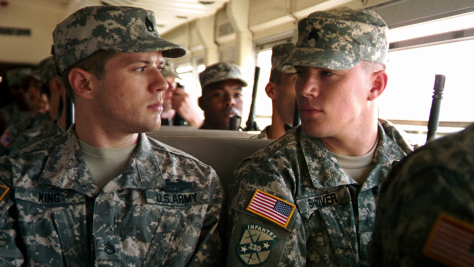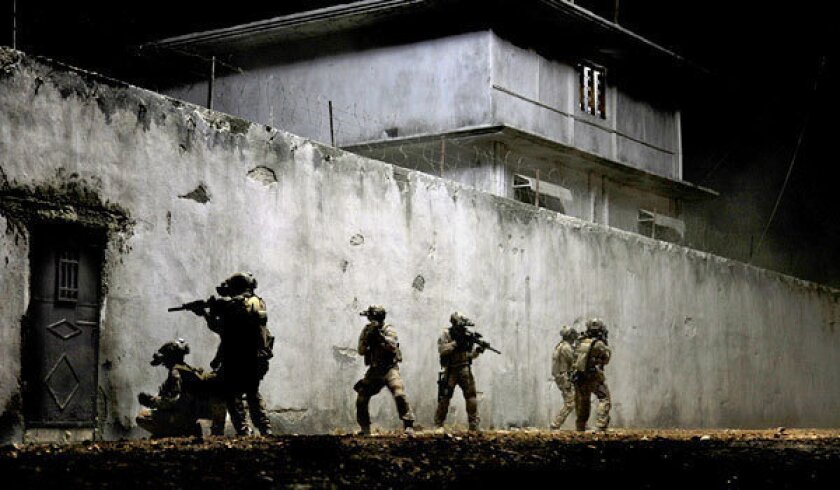By Dennis Hartley
(Originally posted on Digby’s Hullabaloo on November 8, 2025)

Now a note to the President, and the Government, and the Judges of this place
We’re still waiting for you to bring our troops home, clean up that mess you made
Cuz it smells of blood and money and oil across the Iraqi land
But it seems so easy here to blind us with your “United We Stand”
And it ain’t hard to see that this Country ain’t free
– from “Crash This Train”, by Joshua James
Well…this shouldn’t be happening:
As Veterans Day approaches on November 11, more than 1 million US veterans could lose access to food assistance under the Supplemental Nutrition Assistance Program (SNAP), as the federal government shutdown drags into its 35th day, tying the record for the longest shutdown in American history.
According to House committee of veteran affairs, 1.2 million veterans and 22,000 active-duty military families currently rely on SNAP. Studies have shown that veterans are also more likely than non-veterans to experience food insecurity. SNAP, which provides food-purchasing assistance to Americans in low-income or no-income households, currently supports 42 million people across the country.
The situation intensified Tuesday morning when President Donald Trump wrote on Truth Social that SNAP benefits will not be distributed until the shutdown ends.
“SNAP BENEFITS … will be given only when the Radical Left Democrats open up government, which they can easily do, and not before!” Trump wrote in a post on Truth Social, that was also reposted on X by the White House.
Thank you for your lip service, Mr. President.
While we’re waiting for Godot the government to reopen, there are resources available for veterans in need of food assistance. Here are some tips via the ElderLawAnswers website:
Check official messages from your state SNAP office and local area agency on aging. State agencies may post the latest guidance on delays, emergency plans, and whether the state will cover benefits. Keep contact information current so agencies can reach you.
Contact your local Veterans Administration (VA) and veterans service organizations. The Veterans Administration and groups like the American Legion, Veterans of Foreign Wars (VFW), or county veterans’ services may be able to point veterans to veteran-specific emergency food resources or help with applications for other benefits.
Reach out to local meal-delivery programs. Meal-delivery programs, such as Meals on Wheels, can often expand emergency deliveries or connect you to local pantry and transportation help.
Locate nearby food banks and pantry delivery options. Many food banks have increased delivery or drive-through distributions during emergencies, and some may prioritize seniors and those with mobility issues. Check United Way or local nonprofit portals. Keep documentation ready for SNAP appeals or retroactive claims. If benefits are later restored or issued retroactively, having records of communications and missed purchases may help resolve individual issues.
As Mr. Rogers said, “Look for the helpers. You will always find people who are helping.”
And to those who actually have served…thank you for your service.
I am re-posting the following piece in observance of Veteran’s Day. -DH
(Originally posted on Digby’s Hullabaloo on November 11, 2021)

Dress me up for battle
When all I want is peace
Those of us who pay the price
Come home with the least
–from “Harvest for the World”, by the Isley Brothers
Earlier today, my brother posted this on Facebook:
While going through my father’s stuff after his passing we found a large stack of envelopes. They turned out to be letters from junior high students thanking him for the talk he gave the students on Veteran’s Day. It turned out there were over 14 packed envelopes. One for every Veteran’s Day he spoke with the students. My brothers and I were very close to throwing these out with many of the other miscellaneous papers in my Dad’s cabinets but, without even looking at the contents I decided to keep them. I finally opened them up today and started going through them.


I used to kid my late father about being a pack rat but I am grateful that he was. I recall him telling me about giving classroom talks as part of his work with a local Vietnam Veteran’s group, but today was the first time I have ever seen one of those letters. I remember listening to those cassettes he sent us during his tour of duty in Vietnam.
That mention of the Secret Service refers to the 1968 Presidential campaign. Our family was stationed near Dayton, Ohio that year. For the first 17 years of his military service, my dad was an E.O.D. (Explosive Ordinance Detachment) specialist. Whenever presidential candidates came through the area, members of his unit would work with the Secret Service to help sweep venues for explosive devices in preparation for rallies and speeches.
I remember that he helped prepare for appearances by Hubert Humphrey and George Wallace. I remember him showing me a special pin that he had to wear, which would indicate to Secret Service agents that he had security clearance (I’m sure they are still stashed away in one of those boxes).
Today happens to be Veteran’s Day, but every day is Veteran’s Day for those who have been there and back. In honor of the holiday, here are my top 10 picks for films that deal with the aftermath of war.

Americana – David Carradine and Barabara Hershey star in this unique, no-budget 1973 character study (released in 1981). Carradine, who also directed and co-produced, plays a Vietnam vet who drifts into a small Kansas town, and for his own enigmatic reasons, decides to restore an abandoned merry-go-round. The reaction from the clannish townsfolk ranges from bemused to spiteful.
It’s part Rambo, part Billy Jack (although nowhere near as violent), and a genre curio in the sense that none of the violence depicted is perpetrated by its war-damaged protagonist. Carradine also composed and performed the song that plays in the closing credits. It’s worth noting that Americana predates Deer Hunter and Coming Home, which are generally considered the “first” narrative films to deal with Vietnam vets.

The Best Years of Our Lives – William Wyler’s 1946 drama set the standard for the “coming home” genre. Robert E. Sherwood adapted the screenplay from a novella by former war correspondent MacKinlay Kantor.
The story centers on three WW2 vets (Fredric March, Dana Andrews, and Harold Russell), each from a different branch of military service who meet while returning home to the same small Midwestern town. While they all came from different social stratum in civilian life, the film demonstrates how war is the great equalizer, as we observe how the three men face similar difficulties in returning to normalcy.
Well-written and directed, and wonderfully acted. Real-life WW 2 vet Russell (the only non-actor in the cast) picked up a Best Supporting Actor Oscar; one of 7 the film earned that year. Also starring Myrna Loy, Teresa Wright, and Virginia Mayo.

Coming Home – Hal Ashby’s 1978 drama was one of the first major studio films to tackle the plight of Vietnam vets. Jane Fonda stars as a Marine wife whose husband (Bruce Dern) has deployed to Vietnam. She volunteers at a VA hospital, where she is surprised to recognize a former high-school acquaintance (Jon Voight) who is now an embittered, paraplegic war vet.
While they have opposing political views on the war, Fonda and Voight form a friendship, which blossoms into a romantic relationship once the wheelchair-bound vet is released from assisted care and begins the laborious transition to becoming self-reliant.
The film’s penultimate scene, involving a confrontation between Dern (who has returned from his tour of duty with severe PTSD), Fonda and Voight is one of the most affecting and emotionally shattering pieces of ensemble acting I have seen in any film; Voight’s moving monologue in the denouement is on an equal par.
Voight and Fonda each won an Oscar (Dern was nominated in the Best Supporting Actor category), as did co-writers Waldo Salt, Robert C. Jones and Nancy Dowd for their screenplay.

The Deer Hunter – “If anything happens…don’t leave me over there. You gotta promise me that, Mike.” 1978 was a pivotal year for American films dealing head on with the country’s deep scars (social, political and emotional) from the nightmare of the war in Vietnam; that one year alone saw the release of The Boys in Company C, Go Tell the Spartans, Coming Home, and writer-director Michael Cimino’s shattering drama.
Cimino’s sprawling 3 hour film is a character study about three blue collar buddies (Robert De Niro, Christopher Walken and Jon Savage) hailing from a Pennsylvania steel town who enlist in the military, share a harrowing POW experience in Vietnam, and suffer through PTSD (each in their own fashion). Uniformly excellent performances from the entire cast, which includes Meryl Streep, John Cazale, Chuck Aspegren and George Dzundza.
I remember the first time I saw this film in a theater. I sat through the end credits, and continued sitting for at least five minutes, absolutely stunned. I literally had to “collect myself” before I could leave the theater. No film has ever affected me quite like that.

The Manchurian Candidate (1962) – John Frankenheimer’s 1962 Cold War thriller (with a screenplay adapted from Richard Condon’s novel by George Axelrod) stars Frank Sinatra as Korean War veteran and former POW Major Bennett Marco. Marco and his platoon were captured by the Soviets and transported to Manchuria for a period, then released. Consequently, Marco suffers PTSD, in the form of recurring nightmares.
Marco’s memories of the captivity are hazy; but he suspects his dreams hold the key. His suspicions are confirmed when he hears from several fellow POWs, who all share very specific and disconcerting details in their dreams involving the platoon’s sergeant, Raymond Shaw (Laurence Harvey, in a great performance). As the mystery unfolds, a byzantine conspiracy is uncovered, involving brainwashing, subterfuge and assassination.
I’ve watched this film maybe 15 or 20 times over the years, and it has held up remarkably well, despite a few dated trappings. It works on a number of levels; as a conspiracy thriller, political satire, and a perverse family melodrama. Over time I’ve come to view it more as a black comedy; largely attributable to its prescience regarding our current political climate.…which now makes it a closer cousin to Dr. Strangelove and Network). (Full review)

Sir! No Sir! – Most people who have seen Oliver Stone’s Born On The Fourth Of July were likely left with the impression that paralyzed Vietnam vet and activist Ron Kovic was the main impetus and focus of the G.I. veterans and active-duty anti-war movement, but Kovic’s story was in fact only one of thousands. Director David Zeigler combines present-day interviews with archival footage to good effect in this well-paced documentary about members of the armed forces who openly opposed the Vietnam war.
While the aforementioned Kovic received a certain amount of media attention at the time, the full extent and history of the involvement by military personnel has been suppressed from public knowledge for a number of years, and that is the focus of Zeigler’s 2006 film.
All the present-day interviewees (military vets) have interesting (and at times emotionally wrenching) stories to share. Jane Fonda speaks candidly about her infamous “FTA” (“Fuck the Army”) shows that she organized for troops as an alternative to the more traditionally gung-ho Bob Hope U.S.O. tours. Eye-opening and well worth your time.

Slaughterhouse-Five – Film adaptations of Kurt Vonnegut stories have a checkered history; from downright awful (Slapstick of Another Kind) or campy misfires (Breakfast of Champions) to passable time killers (Happy Birthday, Wanda June and Mother Night). For my money, your best bets are Jonathan Demme’s 1982 PBS American Playhouse short Who Am I This Time? and this 1974 feature film by director George Roy Hill.
Michael Sacks stars as milquetoast daydreamer Billy Pilgrim, a WW2 vet who weathers the devastating Allied firebombing of Dresden as a POW. After the war, he marries his sweetheart, fathers a son and daughter and settles into a comfortable middle-class life, making a living as an optometrist.
A standard all-American postwar scenario…except for the part where a UFO lands on his nice, manicured lawn and spirits him off to the planet Tralfamadore, after which he becomes permanently “unstuck” in time, i.e., begins living (and re-living) his life in random order. Great performances from Valerie Perrine and Ron Leibman. Stephen Geller adapted the script.

Stop-Loss – This powerful and heartfelt 2008 drama is from Boys Don’t Cry director Kimberly Peirce. Co-written by the director along with Mark Richard, it was one of the first substantive films to address the plight of Iraq war vets.
As the film opens, we meet Sgt. Brandon King (Ryan Phillippe), an infantry squad leader leading his men in hot pursuit of a carload of heavily armed insurgents through the streets of Tikrit. The chase ends in a harrowing ambush, with the squad suffering heavy casualties.
Brandon is wounded in the skirmish, as are two of his lifelong buddies, Steve (Channing Tatum) and Tommy (Joseph Gordon-Levitt). They return to their small Texas hometown to receive Purple Hearts and a hero’s welcome, infusing the battle-weary vets with a brief euphoria that inevitably gives way to varying degrees of PTSD for the trio. A road trip that drives the film’s third act becomes a metaphorical journey through the zeitgeist of the modern-day American veteran.
Peirce and her co-writer (largely) avoid clichés and remain low-key on political subtext; this is ultimately a soldier’s story. Regardless of your political stance on the Iraq War(s), anyone with an ounce of compassion will find this film both heart wrenching and moving. (Full review)

Waltz With Bashir – In this animated film, writer-director Ari Forman mixes the hallucinatory expressionism of Apocalypse Now with personal sense memories of his own experiences as an Israeli soldier serving in the 1982 conflict in Lebanon to paint a searing portrait of the horrors of war and its devastating psychic aftermath. A true visual wonder, the film is comprised of equal parts documentary, war diary and bad acid trip.
The director generally steers clear of polemics; this is more of a “soldier’s story”, a grunt’s-eye view of the confusion and madness of war, in which none are really to blame, yet all remain complicit. This dichotomy, I think, lies at the heart of the matter when attempting to understand what snaps inside the mind of those who carry their war experiences home.
The film begs a question or two that knows no borders: How do we help them? How do we help them help themselves? I think these questions are more important than ever, for a whole new generation of psychically damaged men and women all over the world. (Full review)

A War – This powerful 2015 Oscar-nominated drama is from writer-director Tobias Lindholm. Pilou Aesbaek stars as a Danish military company commander serving in Afghanistan . After one of his units is demoralized by the loss of a man to a Taliban sniper, the commander bolsters morale by personally leading a patrol, which gets pinned down during an intense firefight. Faced with a split-second decision, the commander requests air support, resulting in a “fog of war” misstep. He is ordered home to face charges of murdering civilians.
For the first two-thirds of the film Lindholm intersperses the commander’s front line travails with those of his family back home, as his wife (Yuva Novotny) struggles to keep heart and soul together while maintaining as much “normalcy” she can muster for the sake their three kids. The home front and the war front are both played “for real” (aside from the obvious fact that it’s a Danish production, this is a refreshingly “un-Hollywoodized” war movie).
Some may be dismayed by the moral and ethical ambivalence of the denouement. Then again, there are few tidy endings in life…particularly in war, which (to quote Bertrand Russell) never determines who is “right”, but who is left. Is that a tired trope? Perhaps; but it’s one that bears repeating…until that very last bullet on Earth gets fired in anger. (Full review)
To learn how you can help vets, visit the Department of Veteran’s Affairs site .

For my father: Robert A. Hartley 1933-2018 (Served in Vietnam 1969-1970)
Previous posts with related themes:
Lest we forget: Films (and thoughts) for Holocaust Remembrance Day




















